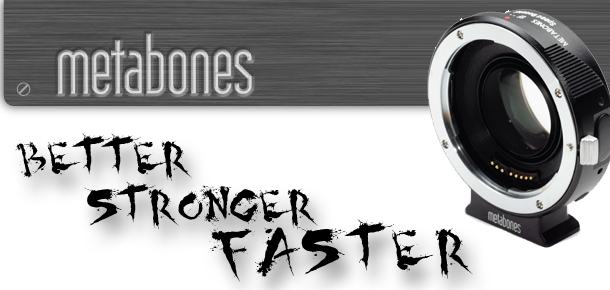New camera gear from Metabones can allow you to actually make your lens wider, sharper, and faster by up to an entire F stop. The company is already well known for their premium lens adapters, which can take glass from another camera type and interface with it as if it were a native lens. With the announcement of the Speed Booster, Metabones says you can now turn your average cropped sensor into the equivalent field of view of a full-framed camera, with the added benefit of being brighter as well. Sounds like photography science fiction, right?
“This is NOT an April Fool’s,” writes cinematographer Philip Bloom on his blog after receiving a review unit. This is quite real, actually. And kind of a big deal. Andrew Reid over at EOSHD concurs, “This is a groundbreaking product for photographers and cinematographers alike.”
In Reid’s tests, he took a full-frame camera lens, the Samyang 35mm F/1.4, and took a picture using a Canon 5D mark III (a full-frame camera). Reid then put the same lens on a Sony NEX7 using the Speed Booster adapter and found that the field of view was almost exactly the same, despite the Sony sensor having a 1.6x crop in comparison to the Canon. Yet the amount of light the NEX7 saw was equivalent to something along the lines of F/1.0 instead of the F/1.4 that the 5D was seeing. In case you aren’t familiar with photography lingo, lower rated F stop numbers are better because it means more light.
How is all this possible? According to Metabones, there is no hocus pocus involved (aw!), but rather some fascinating optical science that involves focal length reducers. The nitty-gritty details can be found on a white paper available on the company’s website. In a nutshell, the explanation goes something like this:
A full-frame lens is designed to cover an entire 35 mm rectangle, be it film or a digital sensor. Cropped sensors like the Sony NEX and Micro4/3 are smaller, so they can only see the center portion of that coverage. Therefore, most of the light passing through the lens is lost around the edges of the sensor. An optical reducer, however, works like the opposite of a magnifying glass, making a circle of light smaller. In this case, our anti-magnifying glass is shrinking the full-frame image down to something that fits over the dimensions of a smaller sensor, thereby wasting less of the light.
By shrinking the image, you’re not only making the view wider, but actually also improving the quality of it as well. Softness, chromatic aberration, and other lens flaws become smaller and almost hidden by reducing the overall coverage enough. Because more photons hit the sensor at any given point, it is also as if there is more light in the scene coming in. That means you can turn down your ISO, raise your shutter speed, and get better shots in low or natural light. Imagine, for example, that you have a flashlight. The further away from the wall you get, the larger the circle of light becomes and the dimmer the light becomes as it scatters as well. The closer you get, however, the more intense and bright the circle becomes as it gets smaller. That’s precisely the theory behind this Metabones adapter: take the image and make it smaller, faster, and better.
My first impression was why on Earth has this never been done before? For starters, full-frame cameras fetch a premium. If everyone could suddenly make (relatively) inexpensive cropped sensor cameras take on the same view as full-frame cameras and with more light, it might ultimately hurt the sales of “pro” cameras. I wouldn’t be surprised if camera companies would very much like to see this not happen. There are also rumors that Kodak has been holding onto patents for wide optical converters, but that patent is possibly up to expire soon.
Another rumor floating about is that some Olympus micro 4/3rds lenses, such as 14-35 and 35-100 f2.0 zooms are full-frame 24-70 & 70-200 lenses redesigned with focal length reducers built in. Another technical issue is that this concept only works if the lens is made to cover a significantly larger area than the actual sensor. In this prototype example, a full-frame EOS lens was adapted to cover the 1.6x cropped NEX7 body. A lens already made for your camera won’t benefit from this method at all.
The adapter Metabones has sent around is a prototype, but more options for other types of lenses and camera bodies are expected soon. A proposed price for the Speed Booster adapter is expected to start at $399 for simple mounts and up to $599 for ones with complicated electronics such as EOS lenses. I don’t like to throw around words like revolutionary, but consider that this could magically make your relatively inexpensive DSLR a full-frame camera with better light sensitivity. Revolutionary seems like a fitting word.




Comments are closed.